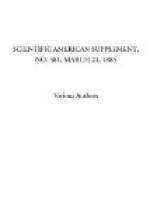I leave, for a moment, the agreeable task of describing one of these homes of native American labor, and pass on to the question of education, whose universality among native Americans is perhaps most vividly illustrated by the following facts. Of 1,200 persons born in Massachusetts, whether of native or foreign parents, only one is unable to read or write, while four Germans and Scotch, six English, twenty French Canadians, twenty-eight Irish, and thirty-four Italians, out of every 100 emigrants of these nationalities respectively are illiterate. The total number of public, elementary, and high schools in the United States is 225,800, or about one school for every 200 of the entire population, and one for, say, every fifty of the 10,000,000 pupils who attended school during the census year of 1880. Finally, referring once more to Massachusetts, there are nearly 2,000 free libraries in this single State, or one to every 800 inhabitants, and these, together, own 3,500,000 volumes, and circulate 8,000,000 of volumes annually.
With regard to sobriety, it is well known that local option succeeds in closing the liquor saloons in very many operative American towns, and with the happiest results. The county of Barnstaple in Massachusetts, for example, with a population of 32,000 souls, and having no licensed liquor saloons, yields a crop of only three convictions per annum for drunkenness. The county of Suffolk, on the other hand, with a population of nearly 400,000, and a license for every 175 of its inhabitants, acknowledges one drunkard for every 50 of its population. The labor in one case is nearly all native; in the other, largely foreign.
It is almost, if not quite, impossible to obtain the statistics of pauperism in America. The “indoor” poor, as paupers in almshouses are called, can be found and counted with comparative ease, but how can the outdoor paupers be found? It is no use inquiring for them from door to door, and the poor-master’s disbursements are so limited in amount that his bills for pauper relief become mixed up with other items, so that they cannot be separately stated. The total number of paupers resident in American almshouses is 67,000, or about one in every 70,000 of the whole population. In England, we have still one pauper in every fifty thousand of the population. Such being the more important aspects of native American labor, as displayed by the statistician, it is time for the social observer to give his account of a typical American artisan’s home.
We are at Ansonia, in the Naugatuck valley, one of the chief towns of “Clockland,” where, within a radius of twenty miles, watches and clocks are made by millions and sold for a few shillings apiece. Our friend Mr. S. is an Ansonia mechanic who occupies a house with a basement of cut stone and a tasteful superstructure of wood, having a wide veranda, kitchen, parlor, and bed-room on the ground floor and three bedrooms above. The house is painted white, adorned




